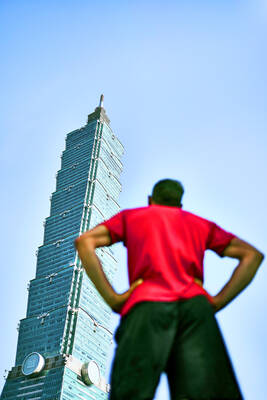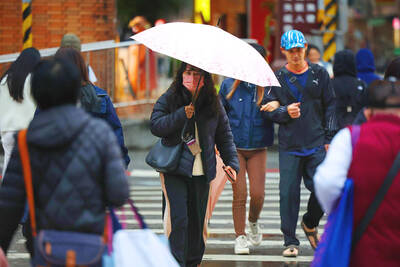Lawmakers and academics are calling on the government to refrain from using the term “mainland” in reference to China in official documents in an effort to put an end to the “one country, two areas” framework that the former Chinese Nationalist Party (KMT) government had envisioned.
“China” has been an internationally recognized term used to refer to China by countries like the US and Japan, which do not call the country of 1.3 billion the “mainland,” New Power Party Legislator-at-large Hsu Yung-ming (徐永明) said.
“Out of respect, Taiwan should also use the term ‘China.’ If we call the other side of the Taiwan Strait ‘Mainland’ or ‘Mainland China,’ we are subjecting ourselves to the ‘one country, two areas’ framework and recognizing that Taiwan is a part of China,” he said.
Unlike former premier Lin Chuan (林全), who referred to China either as “ the mainland” or “Mainland China” in his public remarks, Premier William Lai (賴清德) has been using “China” exclusively, even after assuming the premiership, Hsu said.
He suggested that government agencies follow Lai’s example and use “China” as the unified appellation for China in their official language.
Echoing Hsu’s views, Democratic Progressive Party (DPP) Legislator Lin Chun-hsien (林俊憲) said that addressing China as “China” conforms to reality, while using “mainland” or “Mainland China” constitutes a continuation of the KMT’s ideology.
“The government has the right to decide on the type of language it prefers to use in official documents, a decision that should be free of Chinese restriction,” Lin Chun-hsien said.
If such a minor term change would end up stirring the water in the Taiwan Strait, that would only expose China’s hegemonic mindset, Lin Chun-hsien said, adding that the government’s benevolent gesture of calling Beijing “Mainland China” has only been met with continued suppression efforts from China.
The need to rectify the government’s designation for China was also expressed by academics.
National Chengchi University Graduate Institute of Taiwanese Literature professor Chen Fang-ming (陳芳明) said he agreed with the way Lai addressed China and did not see it as a dereliction of duty.
It is natural for former president Ma Ying-jeou (馬英九) of the KMT to refer to China as “the mainland” given that he is an adamant champion of the so-called “1992 consensus,” Chen said, referring to a tacit understanding purportedly reached between the KMT and the Chinese Communist Party in 1992 that both sides of the Taiwan Strait acknowledge that there is “one China,” with each side having its own interpretation of what “China” means.
Former Mainland Affairs Council Chairman Su Chi (蘇起) in 2006 said he had made up the term in 2000.
“As president Tsai Ing-wen’s (蔡英文) administration does not recognize the ‘1992 consensus’ and Lai is using the term ‘China,’ the government should change what it calls China in official documents to avoid being seen as saying Taiwan is part of China, like Ma,” Chen said.
On the other hand, if Tsai wishes to establish relations with the other side of the Taiwan Strait, she should “take into consideration” the issues that China pays attentions to, National Chengchi University Institute of International Relations director Arthur Ding (丁樹範) said.
He advised the government to “temporarily hold off” on making changes to its designation for China in official documents, or else it might only augment China’s mistrust of the DPP.
A high-level government official, who spoke on condition of anonymity, said that the Presidential Office and the Ministry of Foreign Affairs have adhered to the principles of sovereignty, dignity and equality in their references to China, despite the use of different terms.
“Which terms they choose to use depends on the rhetorical context. There are ‘the other side,’ ‘Mainland China,’ ‘Beijing government’ and ‘China.’ Similarly, we also use ‘Washington,’ the ‘US side’ or the ‘US’ in different contexts,” the official said.
The government’s use of China’s full state name in the aftermath of several diplomatic crises, such as Panama’s severance of ties with Taiwan, suggests that it takes the principle to heart, the official added.

US climber Alex Honnold is to attempt to scale Taipei 101 without a rope and harness in a live Netflix special on Jan. 24, the streaming platform announced on Wednesday. Accounting for the time difference, the two-hour broadcast of Honnold’s climb, called Skyscraper Live, is to air on Jan. 23 in the US, Netflix said in a statement. Honnold, 40, was the first person ever to free solo climb the 900m El Capitan rock formation in Yosemite National Park — a feat that was recorded and later made into the 2018 documentary film Free Solo. Netflix previewed Skyscraper Live in October, after videos

Starting on Jan. 1, YouBike riders must have insurance to use the service, and a six-month trial of NT$5 coupons under certain conditions would be implemented to balance bike shortages, a joint statement from transportation departments across Taipei, New Taipei City and Taoyuan announced yesterday. The rental bike system operator said that coupons would be offered to riders to rent bikes from full stations, for riders who take out an electric-assisted bike from a full station, and for riders who return a bike to an empty station. All riders with YouBike accounts are automatically eligible for the program, and each membership account

NUMBERS IMBALANCE: More than 4 million Taiwanese have visited China this year, while only about half a million Chinese have visited here Beijing has yet to respond to Taiwan’s requests for negotiation over matters related to the recovery of cross-strait tourism, the Tourism Administration said yesterday. Taiwan’s tourism authority issued the statement after Chinese-language daily the China Times reported yesterday that the government’s policy of banning group tours to China does not stop Taiwanese from visiting the country. As of October, more than 4.2 million had traveled to China this year, exceeding last year. Beijing estimated the number of Taiwanese tourists in China could reach 4.5 million this year. By contrast, only 500,000 Chinese tourists are expected in Taiwan, the report said. The report

Temperatures are forecast to drop steadily as a continental cold air mass moves across Taiwan, with some areas also likely to see heavy rainfall, the Central Weather Administration (CWA) said. From today through early tomorrow, a cold air mass would keep temperatures low across central and northern Taiwan, and the eastern half of Taiwan proper, with isolated brief showers forecast along Keelung’s north coast, Taipei and New Taipei City’s mountainous areas and eastern Taiwan, it said. Lows of 11°C to 15°C are forecast in central and northern Taiwan, Yilan County, and the outlying Kinmen and Lienchiang (Matsu) counties, and 14°C to 17°C